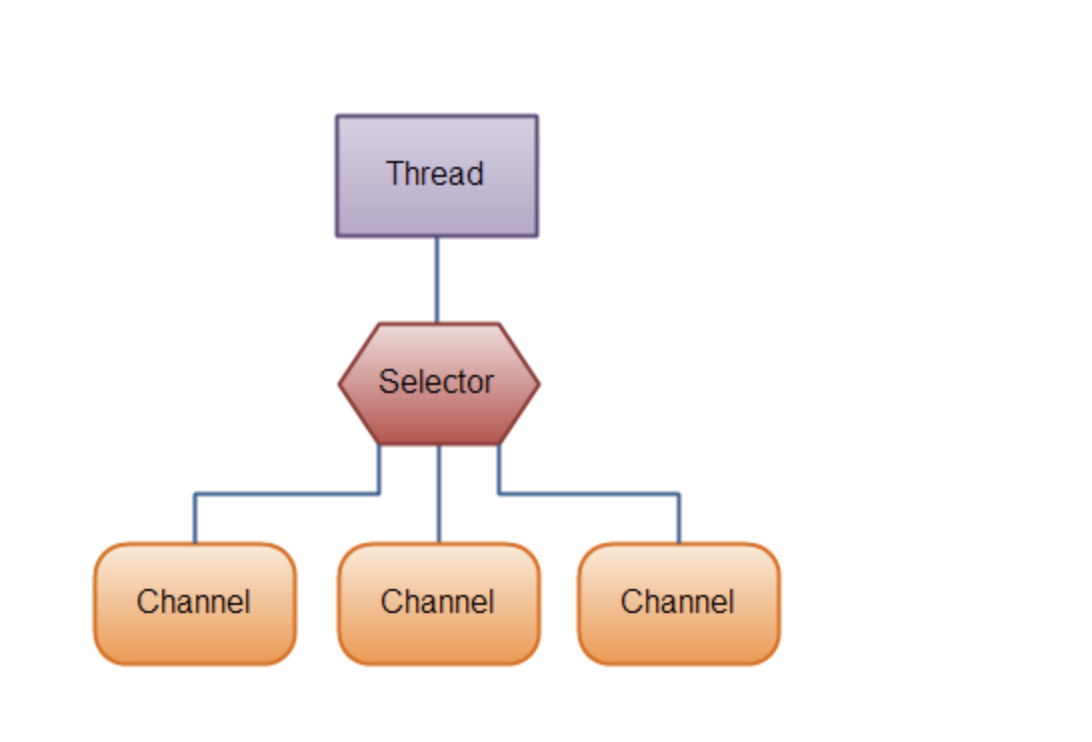2、NIO详解之网络编程
前言
篇将重点介绍基于网络编程NIO(异步IO)。
Selector
在我的JavaNIO详解(一)中已经详细介绍了Java NIO三个核心对象中的Buffer和Channel,现在我们就重点介绍一下第三个核心对象Selector。
Selector是一个对象,它可以注册到很多个Channel上,监听各个Channel上发生的事件,并且能够根据事件情况决定Channel读写。这样,通过一个线程管理多个Channel,就可以处理大量网络连接了。
有了Selector,我们就可以利用一个线程来处理所有的channels。线程之间的切换对操作系统来说代价是很高的,并且每个线程也会占用一定的系统资源。所以,对系统来说使用的线程越少越好。
但是,需要记住,现代的操作系统和CPU在多任务方面表现的越来越好,所以多线程的开销随着时间的推移,变得越来越小了。实际上,如果一个CPU有多个内核,不使用多任务可能是在浪费CPU能力。只要知道使用Selector能够处理多个通道就足够了。

Selector
1、创建一个Selector
异步 I/O 中的核心对象名为 Selector。Selector 就是您注册对各种 I/O 事件兴趣的地方,而且当那些事件发生时,就是这个对象告诉您所发生的事件。
Selector selector = Selector.open();2、注册Channel到Selector
为了能让Channel和Selector配合使用,我们需要把Channel注册到Selector上。通过调用 channel.register()方法来实现注册:
channel.configureBlocking(false);
SelectionKey key =channel.register(selector,SelectionKey.OP_READ); 注意,注册的Channel 必须设置成异步模式 才可以,,否则异步IO就无法工作,这就意味着我们不能把一个FileChannel注册到Selector,因为FileChannel没有异步模式,但是网络编程中的SocketChannel是可以的。
需要注意register()方法的第二个参数,它是一个“interest set”,意思是注册的Selector对Channel中的哪些时间感兴趣,事件类型有四种:
. Connect 某个Channel成功连接到另一个服务器称为 Connect Ready
. Accept 一个ServerSocketChannel准备好接收新连接称为 Accept Ready
. Read 一个有数据可读的通道可以说是 Read Ready
. Write 等待写数据的通道可以说是Write Ready。
SelectionKey
1、 请注意对register()的调用的返回值是一个SelectionKey。 SelectionKey 代表这个通道在此 Selector 上的这个注册。当某个 Selector 通知您某个传入事件时,它是通过提供对应于该事件的 SelectionKey 来进行的。SelectionKey 还可以用于取消通道的注册。SelectionKey中包含如下属性:
1. SelectionKey.OP_CONNECT
2. SelectionKey.OP_ACCEPT
3. SelectionKey.OP_READ
4. SelectionKey.OP_WRITE2、、Channel 和Selector
我们可以通过SelectionKey获得Selector和注册的Channel:
Channel channel = selectionKey.channel();
Selector selector = selectionKey.selector(); 3、通过Selector选择通道
一旦调用了select()方法,它就会返回一个数值,表示一个或多个通道已经就绪,然后你就可以通过调用selector.selectedKeys()
int num = selector.select();4、selectedKeys()
一旦调用了select()方法,它就会返回一个数值,表示一个或多个通道已经就绪,然后你就可以通过调用selector.selectedKeys()方法返回的SelectionKey集合来获得就绪的Channel。请看演示方法:
Set<SelectionKey> selectedKeys = selector.selectedKeys();当你通过Selector注册一个Channel时,channel.register()方法会返回一个SelectionKey对象,这个对象就代表了你注册的Channel。这些对象可以通过selectedKeys()方法获得。你可以通过迭代这些selected key来获得就绪的Channel,下面是演示代码:
Set<SelectionKey> selectedKeys = selector.selectedKeys();
Iterator<SelectionKey> keyIterator = selectedKeys.iterator();
while(keyIterator.hasNext()) {
SelectionKey key = keyIterator.next();
if(key.isAcceptable()) {
// a connection was accepted by a ServerSocketChannel.
} else if (key.isConnectable()) {
// a connection was established with a remote server.
} else if (key.isReadable()) {
// a channel is ready for reading
} else if (key.isWritable()) {
// a channel is ready for writing
}
keyIterator.remove();
}5、举例说明
package com.hlj.nio.Study;
import sun.applet.Main;
import java.io.IOException;
import java.net.InetSocketAddress;
import java.net.ServerSocket;
import java.nio.ByteBuffer;
import java.nio.CharBuffer;
import java.nio.channels.SelectionKey;
import java.nio.channels.Selector;
import java.nio.channels.ServerSocketChannel;
import java.nio.channels.SocketChannel;
import java.util.Iterator;
import java.util.Set;
/**
* @Description
* @Author HealerJean
* @Date 2018/3/28 下午12:20.
*/
public class NetNio {
public static void main(String[] args) throws IOException {
listen();
}
static int port = 1111;
/*
* 注册事件
* */
protected static Selector getSelector() throws IOException {
// 创建Selector对象
Selector selector = Selector.open();
// 创建可选择通道,并配置为非阻塞模式
ServerSocketChannel serverSocketChannel = ServerSocketChannel.open();
serverSocketChannel.configureBlocking(false);
// 绑定通道到指定端口
ServerSocket socket = serverSocketChannel.socket();
InetSocketAddress address = new InetSocketAddress(port);
socket.bind(address);
// 向Selector中注册感兴趣的事件,
// 即指定我们想要监听accept事件,也就是新的连接发 生时所产生的事件,
// 对于ServerSocketChannel通道来说,我们唯一可以指定的参数就是OP_ACCEPT。
serverSocketChannel.register(selector, SelectionKey.OP_ACCEPT);
return selector;
}
/*
* 开始监听
* */
public static void listen() throws IOException {
Selector selector = getSelector();
System.out.println("listen on " + port);
try {
while(true) {
//int select(long timeout):select()一样,除了最长会阻塞timeout毫秒(参数)
//int selectNow(): 不会阻塞,不管什么通道就绪都立刻返回,此方法执行非阻塞的选择操作。
// 如果自从前一次选择操作后,没有通道变成可选择的,则此方法直接返回零。
// int select() 该调用会阻塞,阻塞到至少有一个通道在你注册的事件上就绪,方法将返回所发生的事件的数量。
//select()方法返回的int值表示有多少通道已经就绪。亦即,自上次调用select()方法后有多少通道变成就绪状态。
// 如果调用select()方法,因为有一个通道变成就绪状态,返回了1,
// 若再次调用select()方法,如果另一个通道就绪了,它会再次返回1。
// 如果对第一个就绪的channel没有做任何操作,现在就有两个就绪的通道,
// 但在每次select()方法调用之间,只有一个通道处于就绪状态。
int num = selector.select();
Set<SelectionKey> keys = selector.selectedKeys();
Iterator<SelectionKey> keyIterator = keys.iterator();
while (keyIterator.hasNext()) {
SelectionKey key = (SelectionKey) keyIterator.next();
//Selector对象并不会从自己的selected key集合中自动移除SelectionKey实例。
// 我们需要在处理完一个Channel的时候自己去移除。当下一次Channel就绪的时候,
// Selector会再次把它添加到selected key集合中。
keyIterator.remove();
process(key);
}
}
} catch (IOException e) {
e.printStackTrace();
}
}
/*
* 根据不同的事件做处理
* */
protected static void process(SelectionKey key) throws IOException{
Selector selector = getSelector();
// 接收请求,Channel中什么事件或操作已经就绪
if (key.isAcceptable()) {
ServerSocketChannel server = (ServerSocketChannel) key.channel();
SocketChannel channel = server.accept();
channel.configureBlocking(false);
channel.register(selector, SelectionKey.OP_READ);
}
}
}
因为外面还有一个while 死循环
1、请注意循环中最后的keyIterator.remove()方法。Selector对象并不会从自己的selected key集合中自动移除SelectionKey实例。我们需要在处理完一个Channel的时候自己去移除。当下一次Channel就绪的时候,Selector会再次把它添加到selected key集合中。
2、SelectionKey.channel()方法返回的Channel需要转换成你具体要处理的类型,比如是ServerSocketChannel或者SocketChannel等等。
太多了,请观察博客https://blog.csdn.net/suifeng3051/article/details/48441629
如果满意,请打赏博主任意金额,感兴趣的请下方留言吧。可与博主自由讨论哦
| 支付包 | 微信 | 微信公众号 |
|---|---|---|
 |
 |
 |



